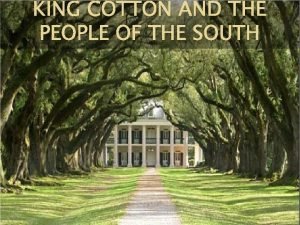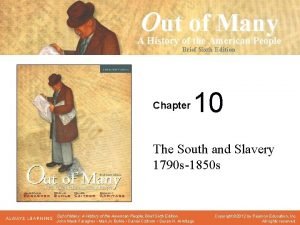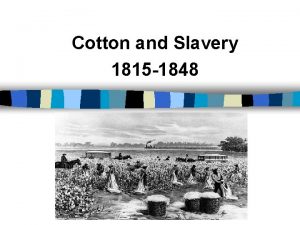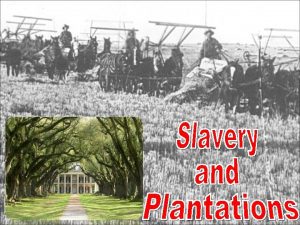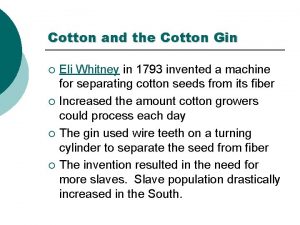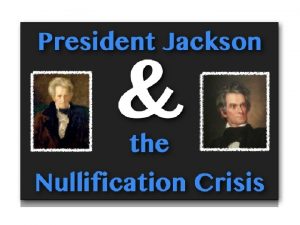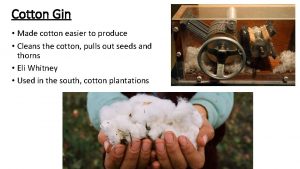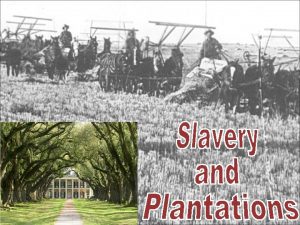Cotton and Slavery 1815 1848 The Cotton Gin














- Slides: 14

Cotton and Slavery 1815 -1848

The Cotton Gin The invention of cotton gin in 1793 made short-staple cotton profitable. n Thereafter, cotton and slavery began to expand - from the Atlantic Coast to Texas. n

Cotton Production in the South, 1820– 1860 Cotton production expanded westward between 1820 and 1860 into Alabama, Mississippi, Louisiana, Texas, Arkansas, and western Tennessee.

Cotton Production • In 1800, the U. S. produced 73, 000 bales of cotton. • By 1820, cotton accounted for 39% of all American exports. • By 1840, cotton accounted for 52% of U. S. exports. • By 1860, cotton accounted for 58% of all American exports and 75% of the world’s entire supply of cotton.

Cotton Exports as a Percentage of All U. S. Exports, 1800– 1860 After 1800, cotton rapidly emerged as the country’s most important export crop and quickly became the key to American prosperity.

Between 1820 -1860, cotton fueled the entire American market economy! • Southern planters sold the cotton and used the income to purchase supplies from the West and goods and services from the North. • Northern factories made money by turning raw cotton into cloth and northern merchants profited from shipping the cotton and reshipping the finished textiles. Slavery provided the labor for this American market economy; thus, slavery was a NATIONAL institution that spread its influence throughout the entire nation!

Because slave labor produced the cotton, increasing exports strengthened the slave system itself.

Slave Population, 1820– 1860 Slavery spread southwestward from the upper South and the eastern seaboard following the spread of cotton cultivation.

• In 1820, cotton production and slavery was concentrated in the upper south. • By 1860, cotton production and slavery had spread to the lower south. • From the 1840 s forward, cotton production made the southern economy stronger and wealthier than the northern economy.

As slavery grew in the South, so did what many Northerners called “The Slave Power. 1. 2. 3. 4. The planter aristocracy - a very small percent of southern society - controlled the social, political, and economic power of the south. From the first presidential election to the election of Lincoln, Southerners controlled the national government most of the time. The South held disproportionate political power under the Constitution. From 1800 -1860 when the Democrats were the predominate political party - the party of states rights - they used their power to pass federal laws designed to strength slavery as a national institution.

The planter aristocracy - a small percent of southern society - controlled the social, political, and economic power of the south • In 1860, 25% of all Southerners owned slaves. • Of that 25% • 52% owned 1 -5 slaves • 35% owned 6 -9 slaves • 11% owned 20 -99 slaves • 1 % owned 100 or more slaves • Those who owned 20 or more slaves about 3% of the entire white population controlled the social, political, and economic power of the South.

From 1800 -1860, the Democrats used their political power to pass federal laws designed to strength slavery as a national institution • In 1835, after Congress failed to pass a law prohibiting the Post Office from sending “incendiary publications” through the mails, Jackson and those who followed tacitly allowed such suppression. • In 1836, Congress banned debating slavery issues in the house. (Was not lifted until 1845. ) • In 1850, the Fugitive Slave Act was passed.

In summary, the expansion of cotton encouraged by the new technology of the cotton gin stimulated the growth of slavery. This economic reality, in turn, was made possible by the “Slave Power. ” This woodcut of a black father being sold away from his family appeared in The Child’s Anti-Slavery Book in 1860.

In summary, the invention of the cotton gin made cotton production and exportation a vital force for the entire American economy. Further, the expansion of cotton stimulated the growth of slavery and made slavery a national institution. These social and economic realities, in turn, were made possible by the “Slave Power. ”
 Ashley gin
Ashley gin Chapter 11 cotton slavery and the old south
Chapter 11 cotton slavery and the old south Chapter 11 cotton slavery and the old south
Chapter 11 cotton slavery and the old south Cotton gin
Cotton gin Cotton gin effects
Cotton gin effects Eli whitney cotton gin
Eli whitney cotton gin Eli whitney cotton gin
Eli whitney cotton gin Eli whitney cotton gin
Eli whitney cotton gin Eli whitney cotton gin
Eli whitney cotton gin Eli whitney invents the cotton gin
Eli whitney invents the cotton gin Eli whitney cotton gin
Eli whitney cotton gin Cotton gin
Cotton gin Cotton gin
Cotton gin Cotton gin inventor
Cotton gin inventor Cotton gin
Cotton gin



